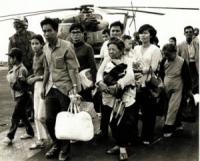Home | Military Conflict | Fall of Saigon
|
|
|
North Vietnamese forces under the command of the Senior General Văn Tiến Dũng began their final attack on Saigon, which was commanded by General Nguyen Van Toan on April 29, with a heavy artillery bombardment. This bombardment at the Tân Sơn Nhứt Airport killed the last two American servicemen that died in Vietnam, Charles McMahon and Darwin Judge.. By the afternoon of the next day, North Vietnamese troops had occupied the important points within the city and raised their flag over the South Vietnamese presidential palace. South Vietnam capitulated shortly after. The city was renamed Ho Chi Minh City, after communist leader Ho Chi Minh. The fall of the city was preceded by the evacuation of almost all the American civilian and military personnel in Saigon, along with tens of thousands of South Vietnamese civilians associated with the southern regime. The evacuation culminated in Operation Frequent Wind, which was the largest helicopter evacuation in history. In addition to the flight of refugees, the end of the war and institution of new rules by the communists contributed to a decline in the population of the city. |




 RSS
RSS